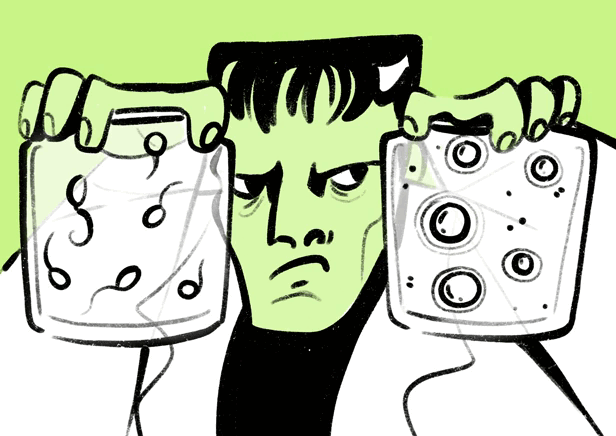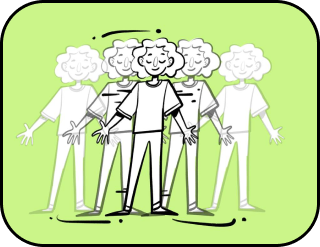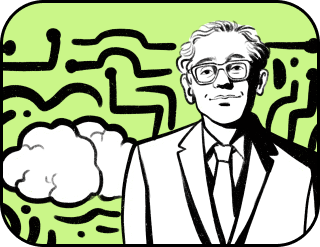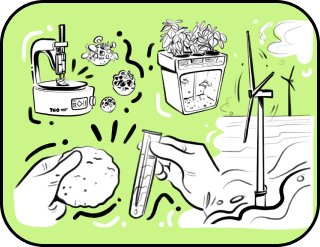How not to become Dr. Frankenstein: the ethics of genetic modification
“We are approaching a point where we will be able to create people who, in some sense, will be objectively better than others.”
From Kazuo Ishiguro’s novel Never Let Me Go
The premise of this task, with its ambiguous title, is quite simple—a basic laboratory and a basic geneticist facing a very complex task: creating the perfect human being.
You might think, what’s so hard about that? A perfect person should be cheerful, so you need to mix two parts of blue eyes with a concentrated dose of red hair. A perfect person must also be brave, so the miracle test tube needs a few drops of Nordic blood, stabilized with the preserved plasma of great warriors. Finally, a perfect person should be intelligent, so the test tube must contain amino acids synthesized in the bodies of physicists, or at least quantum particles extracted from the scientific lab next door.
We stand on the threshold of a revolutionary step where the process of conceiving a child could be transformed by genetics. Why not use this opportunity to avoid genetic defects, take control of determining the physical traits and personality of a child, and finally learn how to create babies in the image and likeness of our idols? But at the same time, how do we avoid crossing the line and repeating the fate of the infamous Dr. Victor Frankenstein?
There are two solutions to this task with its ambiguous title and simple premise: “I want the perfect baby.” One approach is traditional, based on natural processes with minimal intervention. The other is futuristic, relying on cutting-edge technologies that require external interference.
The familiar, everyday methods of designing perfect children have always amazed with their simplicity and straightforwardness, yet at the same time bordered on madness. Even in the fairy tales we’ve known since childhood, some couples managed to create children without engaging in sex. First, describing the whole process of creating children in books for kids was always considered inappropriate, and second, the authors of such stories understood that the enjoyable process didn’t always guarantee the birth of a perfect person.
Nevertheless, our ancestors found unique methods for planning ideal, designer babies and resorted to peculiar, time-honoured diagnostic techniques.
For example, a newborn could easily be found in a cabbage patch if the stork was delayed in delivering it to the parents, despite the perseverance of this real courier. A boy could be carved from a solid log to produce a Pinocchio, and, inspired by winter tales, one could always sculpt a Snow Maiden out of snow — but that was for the wealthy. And it’s said that pieces of magical dough could yield jolly, lively little lumps — Koloboks. Now, aren’t those perfect children?
In the past century, there were popular recipes for calculating the gender of an unborn child. People of that time didn’t know that the responsibility for the baby’s gender — boy or girl — rests entirely on the father. Therefore, it’s not surprising that mothers who only gave birth to girls were often labeled as “useless.” Even noblewomen with prestigious surnames took extreme measures, accusing their wives of being unable to provide an heir, sometimes going as far as execution.
Women, being women, always dreamed of pleasing their husbands to support their status as family lineage bearers. They sought ways to conceive a boy to prevent conflicts. Nowadays, modern women dive into the ocean of information to absorb advice on which lunar dates are best for conceiving a son.
But the ancestors of modern women were true fighters against fate and knew at least ten effective ways to create a perfect child without any flaws. A woman who dreamed of becoming a mother had to follow numerous strict rules; otherwise, her “sins” could play a cruel trick on her future child.
For example, children conceived during the Great Church Fast, especially on Good Friday, were considered doomed to feeblemindedness. If a pregnant woman violated spiritual guidelines, her chances of giving birth to a healthy baby decreased: the unclean one could replace it with a sick child or, in the worst case, a log.
The appearance of the family’s heir was a direct result of how carefully the mother followed all the rituals. To avoid giving birth to a hunchbacked child, mothers were forbidden to step over pieces of wood — it was considered a bad omen. If she paid attention to people with unusual or repulsive features, it was expected that her future baby would inherit similar traits.
Mute and blind children were sure to be born to a woman who sewed on holidays, “sewing” her baby’s mouth or eyes shut. Crooked objects, glances at fire, or frightening encounters — all guaranteed birthmarks. As for “hairy” cheeks or other unusual features, a mighty wolf was to blame, which had accidentally caught the pregnant woman’s eye and frightened her.
Pregnant women were not allowed to harm wild or domestic animals, otherwise, the appearance of the baby could reveal which animals had suffered at the hands of the expectant mother. For example, if she kicked a chicken, her child would likely not escape getting warts!
A few centuries ago, people believed that women who cursed often would give birth to mute children, or their babies would stutter once they learned to speak. In the world of old superstitions, every detail could play a crucial role in creating the perfect child. The question of who the baby would resemble in the future always concerned parents: would they inherit the character, appearance, or talents of their ancestors? From ancient times, there came a piece of questionable wisdom: “A daughter is only happy if she looks like her father, and a son is happy if he looks like his mother.”
But no matter how desperately women of those times tried to follow all the guidelines, they could not influence the complexity of genetic inheritance. Numerous scientific studies have confirmed that a person’s IQ and appearance are like a symphony, where genes play the notes, and lifestyle sings along in harmony. Every newborn is a unique genetic cocktail, blending parental traits to determine details like eye shape, nose height, lip thickness, skin tone, and hair color.
For instance, double eyelids are a dominant trait, and if both parents have double eyelids, the child is more likely to inherit this feature. A high nose bridge will stand proudly and attract attention if it runs in the family. Dark or light eyes and skin color follow the rules of genetics, with dominant genes dancing in complex rhythms.
A completely different situation arises with height and body shape. Approximately 70% of a person’s height is determined by their parents’ genes, while the remaining 30% depends on nutrition, physical activity, and lifestyle. This means that when dreaming of an ideal figure, parents must consider other factors as well.
Equally fascinating is the genetic mystery of twins: even identical twins, who share the same genotype, can look completely different if they grow up in different climatic conditions.
Appearance can be pieced together like a Lego set, thanks to genes. Nearsightedness and high blood pressure, for example, can also be inherited. If one parent wears glasses, the chances of the child becoming nearsighted increase significantly; if both do, the odds multiply two to four times. The health of the parents is also crucial when talking about inheritance.
It turns out that a child’s IQ and appearance are still part of a genetic lottery, not a set of rules or signs. On one hand, we see how genes set the rhythm, while on the other, the environment and upbringing dance their own part, creating a unique individual. These genetic “building blocks” are the key components from which the unique structure of a new person is built. It’s not just a chance but a complete kit for creating a true masterpiece! A great life decision in design — above all, a familiar one.

In today’s world, a thorough approach is valued, and science recommends applying the same rigor to the creation of ideal children. The development of technology in the next 20 years could play a gigantic role in determining not only a child’s gender but also life itself. So why not bring some scientific variety into what has become “familiar”?
In the future, conception could become as simple as ordering a meal in a restaurant! At least, that’s what scientists from the University of Bath claim. They’ve already created healthy mice by tricking sperm into thinking it was fertilizing a real egg. The researchers have developed a method that allows the creation of healthy mice without the need for eggs. If this technology proves effective in humans, it could enable a single person to “create” their child using only their own cells and a little sperm, with the baby resembling more of a non-identical twin than a clone.
Don’t believe in miracles? Japanese scientists have already made it a reality. They successfully preserved goat embryos in devices filled with a biologically active liquid medium that mimics the amniotic fluid during pregnancy for 30 years. Thanks to this revolutionary development, premature babies now have excellent chances of surviving and becoming healthy, even if they leave the womb as early as 22 weeks. Twenty-two weeks — that’s nearly half the standard pregnancy term! In the near future, this scientific breakthrough may allow mothers to halve the length of their pregnancies.
Egg freezing is not a new technology, but it remains a magic wand for women: you can have children when you want, not when you “have to.” However, like any magic, this procedure is expensive and, unfortunately, does not always produce the desired result.
Chinese biologist He Jiankui shocked the world in his own original way by announcing the birth of the first genetically edited babies. The mutation He Jiankui attempted to create artificially is called CCR5 Δ32, a mysterious name for something found naturally, though only in a few lucky individuals. Experiments with mice revealed something astonishing: CCR5 Δ32 is like a magic key that unlocks new possibilities. People with this mutation are protected from HIV, recover faster from strokes and brain injuries, and their memory and learning abilities surpass those of “ordinary” people. In short, they are true superheroes in the world of recovery.
The scientific community responded with skepticism to He Jiankui’s experiments and even banned him from creating babies with altered DNA, no matter how ideal they might be.
In the world of digital finance, where Bitcoin rises and falls like a rollercoaster, one daring investor took a step beyond the ordinary. He didn’t just leave his mark on the blockchain but also launched a startup with the goal of creating real designer babies. No, he wasn’t planning to edit DNA at the egg level; this was true biohacking: genetic therapy carried out directly on the testicles of male volunteers.
Men with upgraded sperm DNA will be ready for fertilization, passing on “enhanced” DNA to future generations. It’s a bold start with a $2 million budget and plans to move from animal tests to the first human experiment. The brave startup team is convinced that medical breakthroughs are on the line, along with the possibility of revolutionizing how we evolve.
What can be said? There are still true pioneers in the world of biology, for whom experimentation is a sacred ritual, and human genomes are canvases for creativity. They refuse to let governments dictate the rules of the game, and many have begun testing unproven genetic possibilities on themselves. One such pioneer injected himself with a syringe full of mysterious DNA cocktails and was later found dead. Another test subject boldly injected “genetic ingredients” right at a San Francisco conference in 2017, as casually as if it were a routine allergy shot!
In the biohacker community, the idea of altering one’s own sperm is seen as something completely normal. Yet, no one can predict where this risky path of experimentation will lead. It could be a ticket to a world of biological wonders, or it could turn out to be another failed experiment.
A New York biotechnology company has proposed its own method of creating ideal babies with unique DNA — the Velocimouse technique. Using this method, specialists carefully extract stem cells from one embryo and, after making several genetic manipulations, implant them into another embryo. It seems like we’ve seen something similar in world history before. The world could become a place where both mice and humans are created in a new image.
The revolutionary Crispr-Cas9 technology has also contributed to the future of human perfection. It offers a kind of genetic “antivirus” that finds traces of viral DNA in a microbe’s genome, cuts it out, or forces the bacteria to self-destruct. The task of this genetic cleaner and its peers is to try to make every little human perfect: perfectly healthy, flawlessly beautiful, and incredibly smart. This is quite an optimistic scenario! However, there is a serious risk that “edited” babies could develop unexpected side effects, leading to many unforeseen problems.
Soon, scientific progress will allow parents to choose their future child’s gender in advance and even program certain tendencies, like a preference for sports or mathematics. Genetic engineers make bold claims that in the next 40-50 years, “gene editing will be used for various enhancements: blond hair and blue eyes, athletic abilities, improved reading and math skills, and so on.” Over time, “designing” children will become increasingly universal.
But as with any invention, there are reasons for pessimism when it comes to genetically programming perfect children. Those without enough privilege are unlikely to have access to these scientific marvels. The world has already encountered the phenomenon of creating a genetically superior “superhuman” race.
There is an argument that our ability to love one another, with all our imperfections, is far more valuable than this whole endeavour of “improving” children through genetic engineering. Besides, sperm banks aren’t exactly overwhelmed with eager applicants. Love and acceptance are the secret ingredients that must find a meaningful place in these experimental processes. That is true magic.
Dr. Frankenstein showed us that it’s not enough to create a perfect being; you also need to create a perfect world for that being. Is that even possible?
“A world where love and family are mere imperfect artefacts of the past. Natural reproduction is a distant fantasy, and marriage has become something as indecent as wearing the wrong shoes. Here, people aren’t born — they’re grown! Branding and casting, like in a fashion show: in incubators, under artificial, dead light. Caring workers in pristine white lab coats and rubber ‘corpse’ gloves turn embryos into well-calibrated members of society. The society has only five castes, and intelligence is the main key to the highest society in this ‘serene’ world…”
This is how Aldous Huxley described the future world in his satirical dystopia Brave New World, set in the year 2540.
Who knows, perhaps this vision of the future is a warning of what could happen if we let science take precedence over human values. And while we can’t yet choose the perfect eye color for the perfect child, we can choose the world we bring them into. A simple solution to a simple problem.
Amusing, unusual, but terrifying…

The atomic fortress has fallen. And our hair stands on end!
Thank you!




